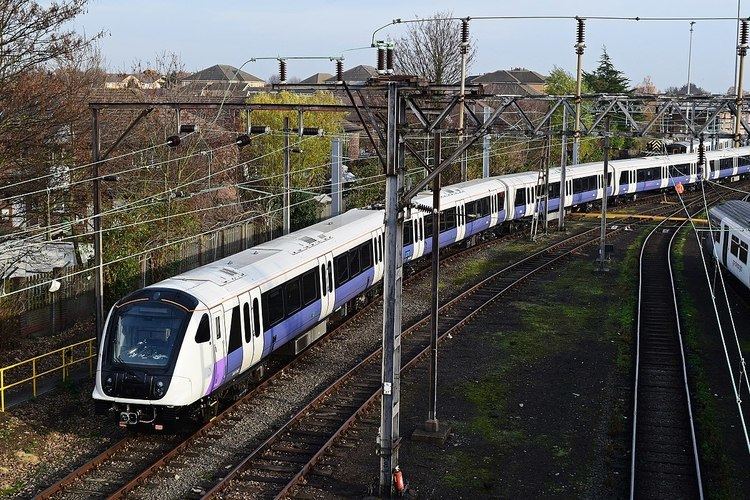In service May 2017 Family name Aventra Number under construction 66 trainsets | Built at Derby Litchurch Lane Constructed 2015–2018 | |
 | ||
Manufacturer | ||
The Class 345 is a Bombardier Aventra design electric multiple unit being manufactured for London's Crossrail. 66 nine-car trains are being manufactured at a cost of £1 billion, with each train able to reach 140 km/h (90 mph) and carry 1,500 passengers. The contract was awarded to Bombardier Transportation in February 2014 and the trains will enter service from May 2017. Initial deliveries are of seven-car sets, which will be extended to 9 car sets at a later date.
Contents
Background and specifications
In 2008 the UK government's rolling stock plan stated a requirement for around 600 carriages for Crossrail, expected to be similar in design to the Thameslink rolling stock, to meet the design improvement requirements of the 2007 'Rail Technical Strategy' (RTS), including in-cab signalling/communication including satellite and ERTMS level 3 technologies, regenerative braking, low cost of operation and high reliability, with low weight and high acceleration.
The publicly released specifications included a passenger capacity of 1,500, with 450 seated, in a fully air-conditioned train no longer than 205 m (673 ft) with a top speed of 145 km/h (90 mph), and an energy efficiency as good as 24 kW·h per train-kilometre. Integration with platform screen doors is also expected. The capital value of the contract, which included construction of a depot at Old Oak Common, was estimated at around £1 billion, the total value may be greater due to the winning bidder expected to undertake maintenance of the trains for three decades, the estimated lifespan of the fleet.
The procurement programme was launched in December 2010. The package valued at approximately £1bn was for 60 high-capacity ten-carriage trains with a capacity of about 1,500 passengers and construction of maintenance depots.
Bidding process and funding
In March 2011, Crossrail announced that Alstom, Bombardier, CAF, Hitachi and Siemens had been shortlisted. The initial bidding process was expected to start in late 2011, with a contract decision in 2013.
In August 2011 the invitation to tender was delayed by one year to 2012 and the contract decision to 2014, with the introduction of trains on the Great Eastern Main Line expected from May 2017 (previously December 2016), with a correspondingly shortened production schedule. The delay was a cost-saving measure to avoid new vehicles being unused whilst Crossrail tunnelling was completed; it also postponed bidding until after a review of governmental procurement processes. Alstom withdrew from the bidding process in August 2011, stating it lacked a suitable developed product. Concerns about taxpayer value for money on PFI funded projects led to Transport for London (TfL) seeking to purchase the trains outright. In December 2011 the request to raise the debt ceiling at TfL to allow the acquisition with public funds was refused by the Department for Transport.
In February 2012 an invitation to negotiate was issued, which included clauses on 'responsible procurement' relating to UK supply chain sourcing and training opportunities; the procurement became politicised after Bombardier failed to win the Thameslink rolling stock programme, and said it may have to close its UK assembly plant (Derby Litchurch Lane) if it did not win the Crossrail contract.
Formal bids were expected in mid-2012, with a decision in early 2014, based on the proposed product meeting the design requirements, and on value for money. Procurement was expected to be partly public and partly privately financed. In September 2012 the government announced that it would underwrite a further £240 million of the project cost under its 'UK Guarantees' infrastructure credit funding scheme, in addition to the 30 per cent of the project being government funded.
Siemens withdrew from the tendering process in July 2013, citing a likelihood of insufficient production capacity in the production timeframe. In December 2013 the European Investment Bank (EIB) agreed to provide loans to Transport for London for the rolling stock of up to £500 million. On 6 February 2014 it was announced that Canada's Bombardier had been awarded a £1bn contract to supply 65 trains, with an option for 18 more.
Fleet details
A total of 66 units, totalling 594 carriages, is to be built.
The trains will initially enter service in May 2017 on the current TfL Rail route between London Liverpool Street and Shenfield as seven-carriage units, since, until the platforms can be lengthened there, the 9-car sets cannot be accommodated at Liverpool Street. The new units will also replace the Class 315s presently used on TfL Rail. Units introduced from May 2018 between London Paddington and Heathrow Airport will be full nine-carriage trains, with those initially delivered in seven-car formation converted by the end of 2019. The trains will have free wifi and 4G available, as well as being fully accessible for wheelchair users. The trains will operate from 25 kV AC OHLE, but will be able to be fitted with shoegear allowing for use with 750V DC third rail, allowing for a possible future extension of Crossrail to Gravesend.
